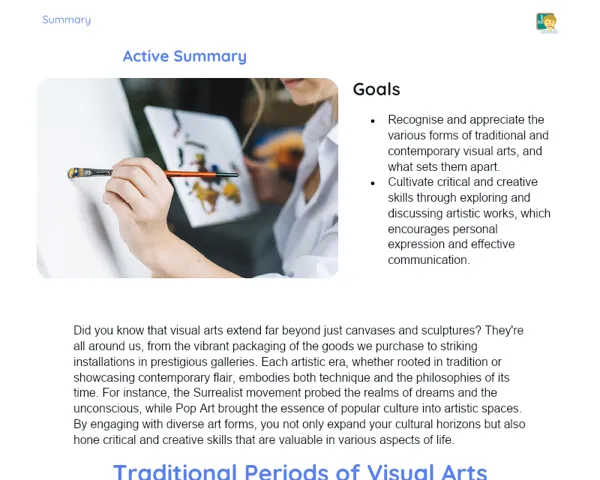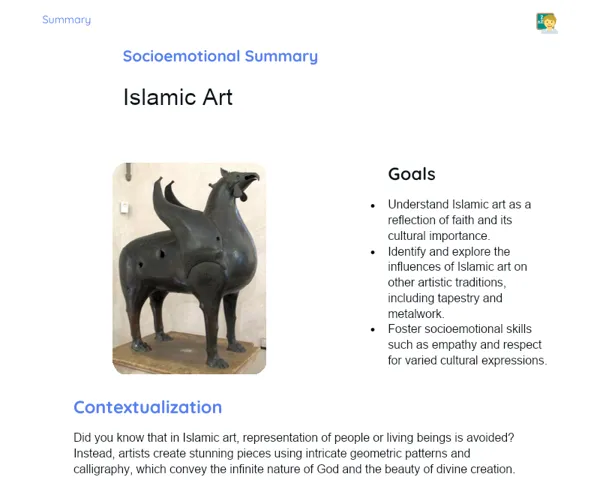Summary Tradisional | Theatrical Elements
Contextualization
Theatre has been a pivotal form of art and communication throughout human history. From ancient civilizations like the Greeks and Romans, people have harnessed the power of theatre to share stories, impart values, and entertain. Various elements come together in theatre to create a rich, immersive experience, including the script, characters, set design, costumes, lighting, and sound. These components are vital to bringing a play to life and keeping the audience engaged.
Interestingly, many theatre elements can be found in our everyday lives, often without us realising it. For instance, when sharing a tale with a friend, we naturally use facial expressions, gestures, and tonality to make our narrative more captivating. These are all theatrical elements that slip seamlessly into our daily interactions.
To Remember!
Script
The script is the written document that outlines all the dialogue, actions, and stage directions performed during the play. It serves as a crucial guide for the actors and production team. Not only does it detail what characters say, but it also indicates when and how they say it, along with specific stage actions and movements.
The script acts as a roadmap for the production, laying out the structure and sequence of events. It's essential to ensure everyone involved understands the story’s progression. Without a clear script, coordinating actions and dialogues could become chaotic and lead to a muddled presentation.
Moreover, scripts can include notes on the desired tone and mood for particular scenes, aiding in crafting the emotional experience for the audience. During rehearsals, scripts are oftentimes revised to better suit actors' strengths and the production's vision.
-
Defines characters' dialogues and actions.
-
Guides the sequence and structure of the play.
-
Can include notes about tone and atmosphere.
Characters
Characters are the heart and soul of the story portrayed in theatre. Each character boasts a unique personality, aspirations, and traits that are key to the plot's progression. Crafting relatable and authentic characters is critical to engage the audience and convey the play's underlying message.
Actors breathe life into characters, using their skills to express the complex emotions, thoughts, and motivations of the roles they portray. This involves employing facial expressions, gestures, and vocal intonation to depict a variety of emotional states and character traits.
Interactions between characters are essential to the storyline, as conflicts, alliances, friendships, and rivalries build intrigue and keep the audience invested in the narrative.
-
Individuals who personify the story.
-
Possess distinct personalities and aspirations.
-
Character interactions are pivotal to the plot.
Set
The set design is the physical space where the action unfolds. It can range from realistic to abstract, but it should always serve the story and immerse the audience in the play's context. The set consists of visual elements like furniture, props, and backdrops.
A skillfully crafted set can whisk the audience away to different times and places, enhancing the overall experience. For example, a detailed 19th-century lounge can firmly ground the play in that era, while a minimalist set might suggest a more conceptual setting.
Beyond establishing time and place, the set can reflect the characters' emotional states or the play's mood. Visual aspects like colours and shapes can be strategically selected to evoke certain emotions or themes, enriching the production's narrative depth.
-
Physical area where the action occurs.
-
Can be realistic or abstract.
-
Helps situate the audience in the context of the play.
Costume
Costumes encompass the garments and accessories worn by actors to present their characters. They help define the time, place, and personality, while also contributing to the play's overall atmosphere. A thoughtfully chosen costume can boost the production's authenticity and help actors connect more deeply with their roles.
Costumes are selected based on thorough research into the historical and cultural backdrop of the play. This may involve studying artworks, photographs, and literary descriptions of the period depicted. Additionally, costumes must be practical, enabling actors to move freely and perform their actions seamlessly.
The colours and styles of the costumes can signal information about the characters. For instance, a villainous character might don dark, stark attire, while a heroic figure could wear lighter, flowing garments. Making these choices allows the audience to grasp the nuances of each character's role in the narrative.
-
Collection of clothing and accessories for the characters.
-
Defines time, place, and character traits.
-
Chosen based on historical and cultural research.
Lighting
Lighting serves to highlight particular actions, foster atmospheres, and guide the audience's focus. Different hues and intensities of light can drastically alter a scene's perception. Light can direct attention toward a specific character or event, creating a focal point on stage.
In addition to emphasising key elements, lighting can craft various atmospheres. Soft, warm lighting can generate feelings of comfort and intimacy, while stark, cold lights can build a sense of tension or foreboding. Lighting can be dynamically adjusted throughout the play to reflect shifts in mood or time.
Advancements in technology allow for a wide range of lighting effects. Computer-controlled lights can be programmed to shift colour and intensity during the performance, enabling smooth transitions between scenes and maintaining the production's rhythm.
-
Highlights actions and directs audience attention.
-
Creates different atmospheres.
-
Can be adjusted to reflect mood or time changes.
Sound
Sound covers both the musical score and sound effects. It serves to build environments, elicit emotions, and complement the dramatic action. The score can be specially composed for the production or selected from existing music that aligns with the theme and tone.
Sound effects add realism and depth to the performance. Sounds like footsteps, doors opening and closing, or rain falling can immerse the audience in the play's world. These effects are typically synchronised with the actors’ movements to provide a cohesive and engaging experience.
In addition to creating environments and authenticity, sound can also hold symbolic meanings. For instance, gentle music may signify a moment of peace, while upbeat tunes can suggest moments of tension or conflict. Thoughtful use of sound can amplify the emotional impact of the play and enhance narrative delivery.
-
Includes soundtrack and sound effects.
-
Creates immersive environments and evokes emotions.
-
Can be symbolically utilised to enhance emotional impact.
Key Terms
-
Theatrical elements: Essential components for creating a theatrical piece.
-
Script: Text that guides dialogues, actions, and stage directions.
-
Characters: Individuals who personify the story in theatre.
-
Set: Physical environment where the action unfolds.
-
Costume: Collection of clothing and accessories of the characters.
-
Lighting: Illumination used to highlight actions and create settings.
-
Sound: Encompasses soundtrack and sound effects to build environments and evoke emotions.
-
Everyday theatricality: The application of theatrical elements in daily situations.
-
Facial expressions: Use of the face to convey emotions and thoughts.
-
Gestures: Body movements employed to communicate actions and feelings.
-
Voice intonation: Variation in tone to express different meanings and emotions.
Important Conclusions
In this lesson, we dissected the core elements that constitute theatre, including the script, characters, set design, costumes, lighting, and sound. Each of these components is crucial for crafting a captivating and coherent theatrical production, aiding in storytelling and engaging the audience's focus.
We also examined the presence of these theatrical elements in our daily lives, often without our conscious awareness. When we share stories and interact, we employ facial expressions, gestures, and varying tones, underscoring the relevance of theatrical insight in our everyday experiences.
We reinforced the significance of theatre as both an art form and a communication medium, highlighting how a deeper understanding of these elements can sharpen our observational, expressive, and communicative abilities. We encourage students to keep exploring the vibrant world of theatre to bolster these skills.
Study Tips
-
Revise the main points discussed in class, concentrating on the six theatrical elements: script, characters, set design, costumes, lighting, and sound. Jot down additional notes if needed.
-
Watch theatre productions, movies, or short clips that exemplify the discussed theatrical elements. Observe how each component enhances the narrative and overall experience.
-
Practice recognising and utilising theatrical elements in your daily life. Experiment with sharing stories with friends or family while employing facial expressions, gestures, and tonal variations to enrich the narrative.



